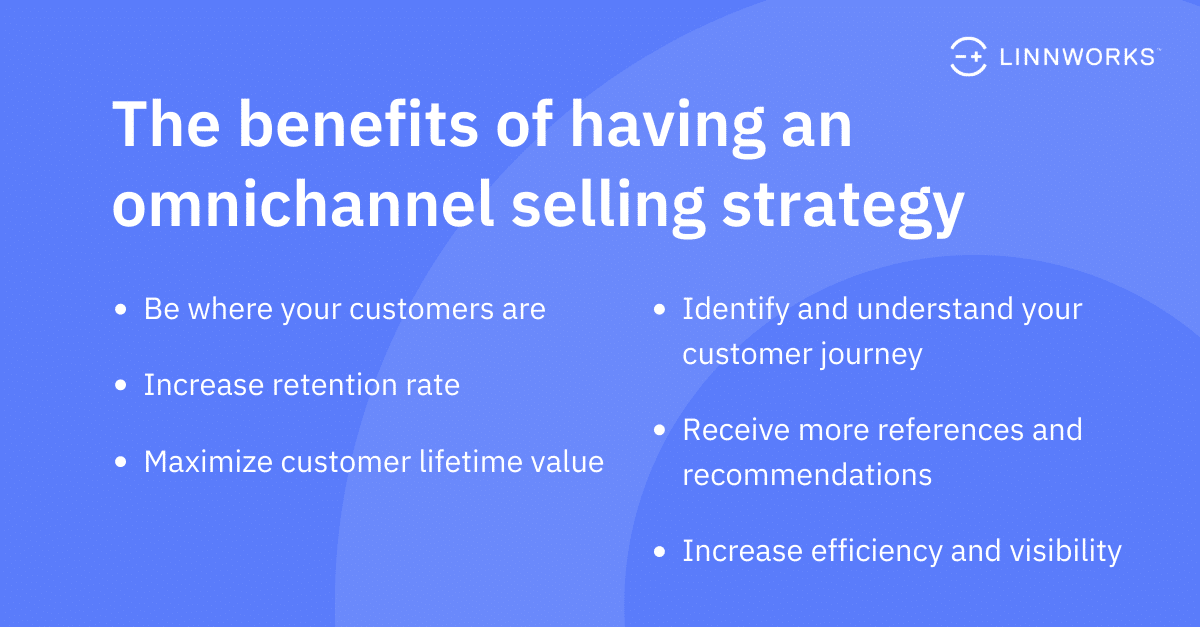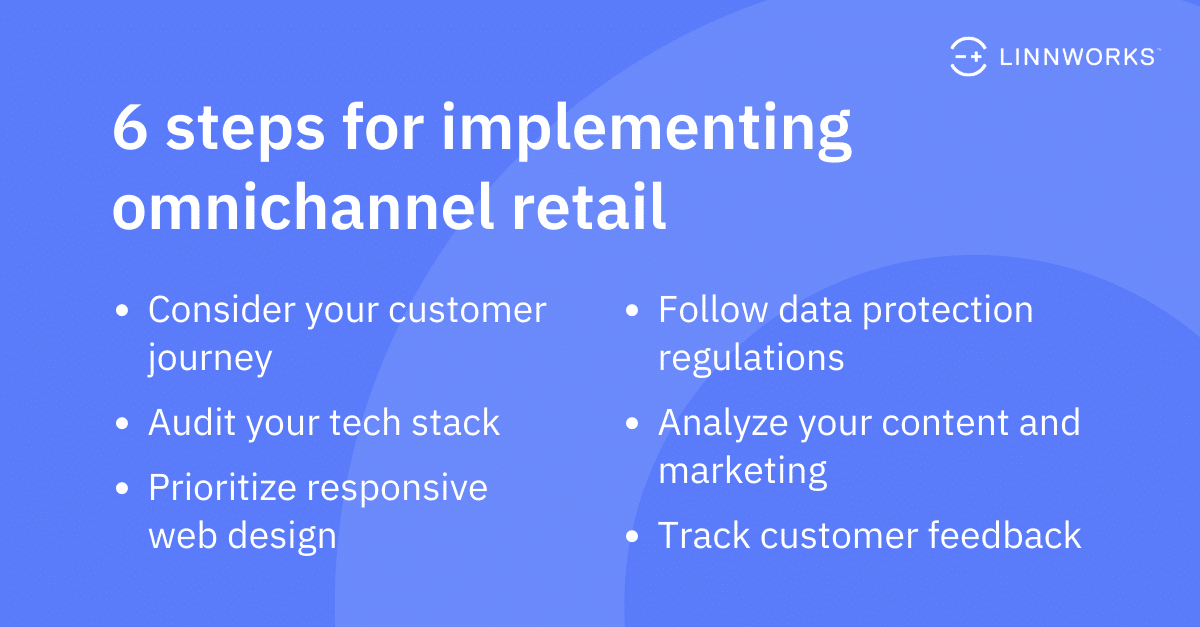What is omnichannel retail and why is it important?
Online shoppers expect a seamless, convenient experience regardless of where they are browsing. Businesses that hope to serve these customers need an omnichannel retail presence if they want to hold off the competition.
Omnichannel retail is an integrated approach that provides a seamless customer experience across channels. That cross-channel service is crucial; selling through your website alone is no longer enough.
Linnworks’ research into the effortless economy found that over 90% of customers start their search on marketplaces. Meanwhile, 82% of consumers enjoy the convenience of social shopping, with 71% preferring to complete their checkout process on a social channel.
In this post, we’ll take a closer look at omnichannel retail, the associated benefits and challenges, and how you can implement your own omnichannel strategy.
What is omnichannel retail?
Omnichannel retail is the practice of creating a seamless experience for every customer across devices and channels, including brick-and-mortar stores and online shopping.
Customers can begin a purchase in one channel and complete it later in a different channel using a different device.
Omnichannel retail vs. multichannel retail
Omnichannel is similar to multichannel retail in that it involves multiple sales channels, but there are key differences.
Multichannel retail strategies focus on expanding sales channels to reach more customers and drive sales. Omnichannel retailing goes further by providing a seamless online shopping experience across those channels. Customers don’t have to restart their browsing or purchase just because they’ve changed channels or are on their laptop instead of their mobile device.
With multichannel retail, retailers expand their reach and influence by placing products in more places. No longer do they have to rely solely on their owned website or physical stores. However, these new channels aren’t necessarily integrated. Customers who browse or start their purchase on one channel might not be able to resume that journey on a different channel, much less a different device.
Benefits of an omnichannel selling strategy
Omnichannel retailing has many benefits, including for customers who appreciate the convenience and flexibility of shopping how, where and when they choose.
Here are key benefits for businesses that have an omnichannel retail strategy.
Be where your customers are
Customers expect to be able to engage with brands across multiple channels, at any time and from any location. Omnichannel retail helps your company do this and expand your total potential audience.
Implementing a multichannel strategy with omnichannel at the core helps you serve customers through social commerce, marketplaces, your website or an in-store experience.
Increase retention
Our research found that nearly two-thirds of shoppers consider convenience and ease of purchase to be top factors in their purchasing decisions. Omnichannel customer engagement strategies help you retain shoppers by giving them a consistent experience while removing roadblocks to ordering.
Another benefit of a consistent cross-channel experience is the wealth of data you gain about customer behavior and preferences. With this data, you create more accurate forecasts and continue to deliver exceptional service at every stage of fulfillment.
Maximize customer lifetime value
Omnichannel retail streamlines communications between brands and customers. When you improve retention and make shopping easier, customers will purchase more often and spend more with your brand over time.
For example, by leveraging insights gathered from multiple sales channels, you can provide personalized recommendations and targeted promotions that drive additional engagement and sales.
Receive more referrals and recommendations
Your omnichannel retail experience delivers a quick, easy and reliable experience for shoppers, which they’re likely to share with their friends, family and social networks. Word-of-mouth referrals and recommendations are incredibly powerful, as they come from trusted sources.
By encouraging customers to share their experiences with their networks, on social media and through review sites, you increase your brand’s visibility and reach new audiences.
Increase efficiency and visibility
Omnichannel retail creates a unified shopping experience for customers across channels and devices, which requires unifying your operations internally. The benefits of streamlining your business for omnichannel retail are felt across your organization.
For instance, a centralized inventory and order management system can increase efficiency and visibility while helping you deliver a great experience for customers regardless of where they shop. Relying on a single cloud-based system helps you simplify and manage orders, inventory and fulfillment processes to reduce costs and improve service.
This platform can provide insights and visibility into products and customers that informs decisions about restocking, fulfillment and forecasting. This also means you can quickly identify potential problems early, such as stockouts, delays and cancellations.

Challenges of omnichannel retail
Omnichannel retail is a big shift from single-channel or even multichannel retail strategies.
Here are some key challenges you’ll need to overcome.
Ensuring a seamless customer experience
Omnichannel requires a seamless shopping experience across channels.
Whether customers are shopping online, in-store or through a mobile app, they expect convenience. The challenge for retailers is making this look easy despite the complexity of managing multiple channels and synchronizing inventory and customer data. Additionally, you need the right technology stack and configurations to align your operations and data with each selling channel’s specifications.
Creating a unified brand experience
Customers want the same experience on every channel as if they’re in your store or on your homepage. Omnichannel retail challenges companies to personalize the shopping experience while also making it feel the same across channels.
While you want customers to feel comfortable buying from you through Amazon or Instagram, for example, you also want them to recognize that it’s you they’re buying from on each of those channels.
Customers also expect a unified brand experience in terms of pricing, shipping options, delivery speed and 24/7 availability.
Seamlessly integrating systems
Businesses need systems that talk to each other. Implementing an omnichannel retail strategy can be difficult because of the many different platforms and tools involved.
For example, your inventory management system needs to integrate with order management, payment and shipping systems, as well as each channel you’re selling on. Any breakdown in communication can lead to inventory inaccuracies, delayed shipments and dissatisfied customers.
6 steps for implementing omnichannel retail
Here’s how to get started on your omnichannel journey.
Consider your customer journey
If you’re targeting everyone, you’re targeting no one.
While omnichannel retail helps you be everywhere your customers are, that doesn’t mean every customer is right for you. Focus on customer origin to get a better idea of their decision drivers.
Examine existing sales data, create customer personas, and categorize customers based on common characteristics or behavior patterns. Then create a journey tailored to each customer type.
Audit your tech stack
Technology has made it easier than ever to implement, track and evaluate your retail strategies. For example, inventory and order management software provides a real-time view of inventory levels and order status across sales channels. This allows you to fulfill orders more efficiently, reduce stockouts and minimize overstocking.
Commerce is moving closer to the consumer. Make sure your tech stack is up to the challenge.
Prioritize responsive web design
Shopping is increasingly mobile, and customers expect your website to be optimized for smartphone browsing.
Responsive design ensures your website automatically adapts to the screen size and resolution of whatever device being used. This contributes to the consistent and seamless experience that shoppers want.
Follow data protection regulations
Thanks to technology, gathering insights about customer behavior has become a lot easier. However, this creates responsibilities around protecting sensitive customer data.
One of the key regulations that businesses need to follow is the EU’s General Data Protection Regulation (GDPR). This regulation requires businesses to obtain explicit consent from customers before collecting and using their data, as well as to provide transparency around how the data is used and stored.
Retailers selling internationally must be especially careful about following data protection regulations wherever they operate. And even single-country sellers must have applicable cybersecurity and data protection measures, along with risk management plans for vendors and partners.
Analyze your content and marketing
Content comes in two main buckets for online retailers: product information and marketing. All of this content should be accurate, up to date and consistent with your brand messaging and values.
As you build out an omnichannel strategy, examine your content to ensure it applies across channels, including marketplaces and social commerce. Review product information to make sure it’s standardized so you aren’t having different or missing information on certain channels. A content audit can reveal such gaps and allow you to fix errors or adjust your messaging.
This process also informs your marketing strategy, especially when you’re using customer data to personalize messaging and marketing efforts. Consider segmenting customers based on attributes such as browsing behavior, demographics or purchase history. This allows you to create campaigns that speak directly to their needs and interests.
You can also add personalization tools, such as dynamic content and product recommendations, to your website and other sales channels. These tools contribute to personalized experiences that help your customers feel at home with your brand wherever they’re encountering you.
Track customer feedback
Make sure you can collect customer feedback in every sales channel — and respond to it in a timely and consistent manner. Some of the ways to collect this type of feedback include forms on your website, social listening tools, post-purchase surveys and customer support interactions.

Find success in every sales channel
Omnichannel retail has many advantages, including personalized shopping experiences, reaching customers through multiple channels, and greater convenience for shoppers.
As you develop your omnichannel strategy, you need the right platform to manage inventory and orders across multiple channels. Learn how an effective multichannel inventory management system helps you have the right product in stock at the right time, every time.